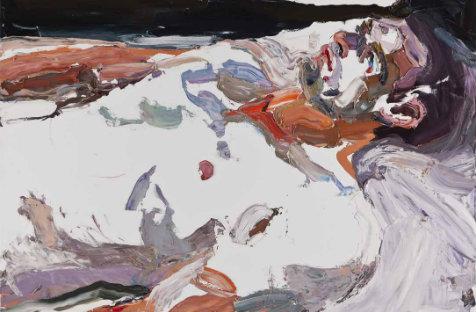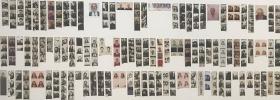A strong smell of paint greets visitors to the National Art School Gallery; an unsurprising aroma given the sheer volume of paint Ben Quilty applies to his canvases.
There are over 20 paintings and 16 drawings in this exhibition of works created by Quilty in his role as official Australian war artist to Afghanistan. Quilty works in his familiar style, thick sensuous paint layers contrasting with areas of untouched white canvas. Here his palette strongly favours reds, oranges, browns and an array of purples, with the occasional stroke of yellow or khaki green. A number of his subjects are portrayed against intense dark black or purple backgrounds.
These paintings seem big, the canvases themselves are large-scale but the works seem bigger than this; Quilty has created powerful images. Naked, twisted bodies and head-on portraits of the men and women who have served as soldiers in Afghanistan reveal much about the personal toll that this war has taken on their bodies and minds.
In October 2011, Quilty travelled to Kabul, Kandahar and Tarin Kot in Afghanistan with the Australian Defence Force as an official war artist. This is a role that many Australian artists have taken up before him, with the Australian Government sending artists overseas – both to active conflicts and peacekeeping regions – since the First World War.
On his return to Australia, Quilty started to work from photographs and sketches he made in Afghanistan but found that this lacked the immediacy he had felt while sitting with these people. He got back in contact with a number of soldiers and asked them to come into his studio and sit for him. Through this process strong friendships were formed; Quilty has talked about how important this aspect of the project is to him.
Many of these young soldiers are portrayed naked, free from uniforms and weaponry, the mental and physical scars of war laid bare for the viewer. The poses their twisted bodies take were chosen by the soldiers themselves, some reflecting actual events and positions they took in combat. In Trooper M, after Afghanistan, no. 2, a young man with arms outstretched lays open the often most guarded parts of his body to Quilty’s brush.
In Kandahar, Quilty renders the Kandahar Airfield, a multinational base which operates 24 hours a day; it is dusty, dark and possesses a violent undertone. Everyone on the base, civilians and military, are armed. The airfield becomes a dark mass against a light background, looking as if it could implode at any moment.
The clothed portraits of Air Commodore John Oddie, a high ranking officer now retired, reveal much about this man who has commanded thousands of troops in the Middle East. There is exhaustion, a hint of a smile and a certain sadness visible on his face. In Air Commodore John Oddie, after Afghanistan, no. 2, Oddie’s face is tilted downwards revealing dark lines under his eyes, while masses of heavy paint around his chin speak of the heaviness of his experiences.
A number of officers have mentioned the therapeutic nature of sitting for these paintings – it seems it was important to both the soldiers and Quilty to talk about their experiences and feelings about the war. Quilty’s choice to reveal the emotional toll of war, something that has often been hidden away, raises awareness of the psychological effects and emotional trauma faced by many soldiers returning home from war.
Rating: 4 stars out of 5
Ben Quilty: After Afghanistan
National Art School Gallery, Darlinghurst
21 February – 13 April





